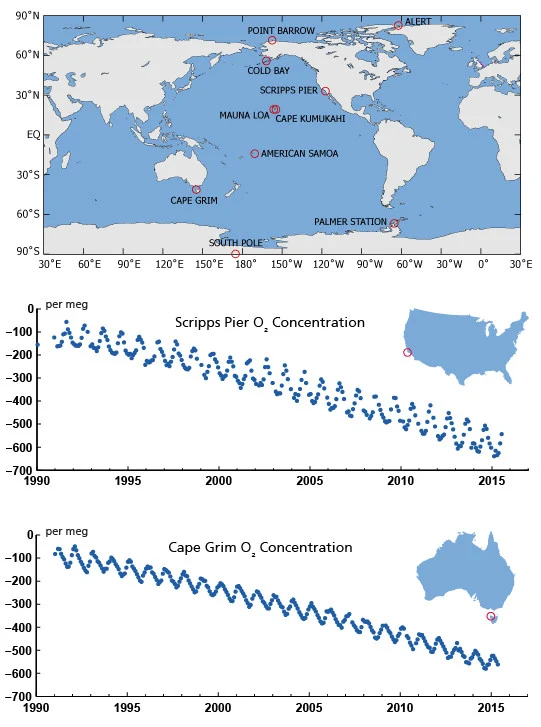Oxygen levels are decreasing globally due to fossil-fuel burning. The changes are too small to have an impact on human health, but are of interest to the study of climate change and carbon dioxide. These plots show the atmospheric O2 concentration relative to the level around 1985. The observed downward trend amounts to 19 'per meg' per year. This corresponds to losing 19 O2 molecules out of every 1 million O2 molecules in the atmosphere each year.
Chart is graded in "megs" meaning number of units per total concentration, drop of 19 per million units per year translates at 20.95% concentration (209,500 ppm) to about 91 ppm total atmosphere per year loss of O2 while at the same time we're only gaining about 5 ppm per year of CO2. Combustion of hydrocarbon also bonds O2 to Hydrogen at a rate of 2 ppm moisture per 1 ppm O2. Oxidation of metals and materials counts down the O2 as well as creation and increase of Ozone O3. The differences in irregularity between Northern and Southern hemispheres reflect the disparate amount of wild fires, land mass and population but globally the O2 diffuses evenly across the planet.
Via scrippso2.ucsd.edu
Chart is graded in "megs" meaning number of units per total concentration, drop of 19 per million units per year translates at 20.95% concentration (209,500 ppm) to about 91 ppm total atmosphere per year loss of O2 while at the same time we're only gaining about 5 ppm per year of CO2. Combustion of hydrocarbon also bonds O2 to Hydrogen at a rate of 2 ppm moisture per 1 ppm O2. Oxidation of metals and materials counts down the O2 as well as creation and increase of Ozone O3. The differences in irregularity between Northern and Southern hemispheres reflect the disparate amount of wild fires, land mass and population but globally the O2 diffuses evenly across the planet.
Via scrippso2.ucsd.edu

This post may contain affiliate links. As an Amazon Associate, I earn from qualifying purchases.